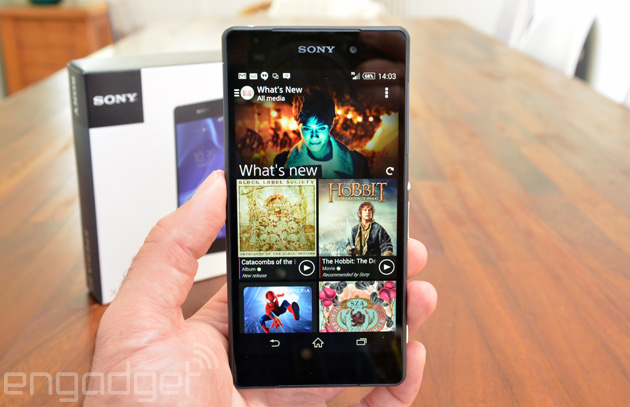
Sony Xperia Z2 review
No, the problem here is with the weight distribution. The Z2 feels wider and taller than it needs to be, and its center of gravity just doesn't feel very... centered. By contrast, the similarly heavy HTC One (M8) feels like its density is gathered around the spine of the device, so that it rests solidly in the hand. None of these handsets are especially conducive to one-handed use, but the Xperia Z2 is the worst of the bunch in this respect; I dropped it four times in the space of a week, which is a record even for me, and I found it unwieldy for reading in bed, too.

Having said this, it's worth remembering just how much technology is packed into the Z2: a 5.2-inch display, a big camera module, the extra ruggedness I've already mentioned, a microSD slot, a widely compatible LTE modem and all the other gubbins listed in the table below.
| Sony Xperia Z2 | |
|---|---|
| Dimensions | 146.8 x 73.3 x 8.2mm |
| Weight | 163g |
| Screen size | 5.2 inches |
| Screen resolution | 1,920 x 1,080 |
| Screen type | Triluminos LCD with 16.7 million colors |
| Battery | 3,200mAh Li-ion (non-removable) |
| Ruggedness | IP55 and IP58 waterproof and dustproof |
| Internal storage | 16GB (12GB free) |
| External storage | MicroSDXC |
| Rear camera | 20.7MP (1/2.3-inch sensor, f/2.0 lens with 27mm equiv. focal length) |
| Front-facing cam | 2MP stills, 1080p video |
| Video capture | 1080p, 4K |
| NFC | Yes |
| Radios |
HSPA+ (850/900/1700/1900/2100); GSM GPRS/EDGE (850/900/1800/1900); LTE (Bands 1, 2, 3, 4, 5, 7, 8, 13, 17, 20) |
| Bluetooth | v4.0, aptX, A2DP |
| SoC | Qualcomm Snapdragon 801 (MSM8974AB) |
| CPU | 2.3GHz quad-core Krait 400 |
| GPU | Adreno 330 |
| RAM | 3GB |
| Entertainment | MHL, USB OTG, WiFi Direct, DLNA, Miracast, FM radio |
| WiFi | Dual-band, 802.11a/ac/b/g/n |
| Wireless Charging | No |
| Operating system | Android 4.4.2 (Sony-specific UI) |
More usefully, Sony has also made room for stereo speakers. These are still a bit tinny compared to HTC's BoomSound, but they're infinitely better than the single speaker on the Z1. The old model's speaker was easily blocked by the palm of your hand when the device was held in landscape mode, but now, the speakers are forward-facing and very hard to block -- a big tick for Sony.
Display

This is a manufacturer that has historically trodden its own path with respect to displays, to the point where Sony TVs and, to some extent, Sony phones, have forsaken deep black levels and vivid colors preferred by the likes of Samsung in favor of more detail and more natural color reproduction. With the Z2, however, it looks like Sony has seen a commercial need to deliver something more akin to its rivals and more familiar to potential buyers. I know a couple of people (just one, actually) who really liked the Z1's display and who might be annoyed by this change of heart, but to my eyes it's all good. We're now looking at a display that is at least on a par with other top-end LCD panels.
A couple of notes about setting up the display: Colors tend to be a bit warm, but you can adjust white balance and add a touch of blue in the settings -- a tweak that I tried and then decided to keep. I also permanently disabled Sony's "X-Reality for mobile" engine, because this post-processing effect has gone too far: It makes things look unnaturally saturated, and it also makes 1080p movies look pixelated due to over-zealous edge sharpening.
Software

Nevertheless, the manufacturer does leave some residue on your Android experience, and it has to be said that this lingering aesthetic feels dated. Whereas HTC and even Samsung have recently tarted up their skins, and Apple has made the stark shift to iOS 7, Sony's icons, fonts and layouts feel like they're stuck in 2012.
Accessing settings is also a bit old-fashioned: You have to open the notifications pulldown, select "quick settings" and then make do with basic toggles, which means most settings (like brightness or selecting a WiFi network) then take a couple more taps before you actually make the desired change. Stock Android, HTC Sense and TouchWiz all handle these mundane things with fewer presses.
Sony Xperia Z2 screen shots
16 Photos
Camera

Still photography
The Xperia Z2's 20-megapixel camera is carried over from the Z1, and that's a good thing. You can check out our Z1 review for an in-depth look at picture quality, including comparisons to the current king of mobile imaging, the Lumia 1020. Suffice to say, this is still the closest you can get to the image quality of a traditional point-and-shoot on a standard-shaped Android phone (i.e., not a Galaxy "Zoom" phone). That means you'll be able to capture decent snaps even if you decide to leave the house without a dedicated camera.Sony Xperia Z2 camera samples
14 Photos

On the whole, I wish Sony had concentrated more on making its camera app more flexible and more suitable to manual photography, the way Nokia has done in recent years. There's no easy way to control ISO or shutter speed in order to get creative using the stock app; the only quick adjustments that can be made are white balance and exposure compensation. It could have also helped us out with better post-production tools, as the one supplied is extremely basic. As things stand, we'll just have to go elsewhere for our photography tools.
Video recording
To some extent, Sony's unnecessary gimmicks also stretch to video recording, since we now have a 4K recording option that only a few people with 4K displays might be able to appreciate. (If you're reading this on a 4K display, make sure you choose the full-res setting on the YouTube video above and, unlike the rest of us, you'll be able to see what these clips really look like).The good news with 4K is that Sony hasn't crushed the data rate as much as I feared, so the footage isn't ruined by compression artifacts. The camera stores about 450MB of data for each minute of 3,840 x 2,160 footage, which equates to 7.5 MB/s -- that's nearly four times higher than the data rate of video recording on the Z1, befitting the quadrupling of the resolution. This is a roundabout way of saying that 4K clips from the Z2 should at least look similar to the 1080p clips we're already used to, with the bonus of higher resolution if and when it's needed.
Unfortunately, my sample footage was let down by the Z2's microphone, which couldn't really handle a windy day by the river, as well as by the lack of optical image stabilization (there's only a conspicuous sort digital stabilization on offer here) and the fact that it's almost impossible to keep your left index finger away from the lens. If you intend to use the Z2 for serious videography, consider investing in a decent mount, along with Sony's new stereo microphone accessory, the STM10 (£30/$50).
Battery life and performance
| Sony Xperia Z2 | Xperia Z1 | HTC One (M8) | |
|---|---|---|---|
| Quadrant 2.0 | 19,100 | 22,145 | 25,548 |
| Vellamo 2.0 | 1,597 | 2,891 | 1,804 |
| AnTuTu 3.2 | 32,574 | 29,377 | 30,100 |
| SunSpider 1.0 (Chrome browser) | 935 | 762 | 772 |
| GFX Bench T-Rex Offscreen (fps) | 27.2 | 23 | 28.2 |
| GFX Bench Manhattan Offscreen (fps) | 11.8 | N/A | 11.1 |
| CF-Bench | 36,699 | 31,702 | 38,526 |
|
Minion Rush median frame rate* |
31 | 31 | 28 |
| Minion Rush battery drain (% per hour)* | 22 | 24 | 22 |
| Battery rundown test | 13.5 | 12.5 | 11.5 |
| *Measured using GameBench Beta. | |||
Moreover, due to the inclusion of a larger 3,200mAh battery, the stamina has increased greatly and is now probably the best of the recent batch of flagships. I say "probably" because these things depend largely on how often it's under load and how much use you make of the various battery-saving features. From my experience with the Z2, it has great longevity when it's mostly in standby, but it gets hot and can occasionally be inefficient when asked to handle more taxing activities. This led to a couple of instances where the battery depleted faster than I expected, but on the whole, I never had less than a third of the battery left by late evening. Our standard looped video corroborates (and perhaps slightly exaggerates) this advantage: The phone lasted a full 13 hours and 30 minutes -- three and half hours longer than the Galaxy S5.
LTE and HSPA+ performance was solid, with connection strength and data speeds being consistent with other phones we've tested on O2's network in London. The phone didn't drop its data connection even when, during a couple of instances, the reception indicator showed zero bars. With a couple of bars of signal strength, I got up and down speeds of around 7 Mbps, which is what I expected. Call quality and reliability held no nasty surprises either. I tried calls with and without background-noise suppression and "speaker voice enhancement," and neither I nor the other party noticed much difference, but in all cases, the audio quality was good.
Wrap-up

The downer is that, personally, I wouldn't buy this phone. If I wanted the Z2's camera, coupled with its high-quality display and fast processor, I'd wait to buy it in a smaller version of the handset -- which hasn't been confirmed yet, but must surely be on the horizon given the level of interest in the Z1 Compact. If I wanted a phablet, I'd get a Galaxy Note 3 or hold out for a Note 4. And if I wanted a big, premium non-phablet, I'd probably go for the HTC One M8 -- it has a more enticing, more comfortable design, along with a nicer UI and better stock apps (especially in the camera department). More objectively, though, I can see what Sony was trying to create with the Z2, and it has arguably succeeded in the areas that matter most. There'll be people out there who appreciate its gorgeous display, solid battery life and granite-like charm, and these attributes are inextricably linked to the phone's size. If you think that might be you, go ahead. This is a safe purchase, the best Sony phone that has ever been, and definitely among the top three Android phones currently on the market.
86
Sony
Xperia Z2
Pros
- Huge, high-quality display
- Rugged construction
- Excellent processor and battery life
- Shoots incredibly detailed stills
Cons
- Unwieldy in the hand
- Sony's Android skin gets in the way sometimes
Conclusion
The Xperia Z2 is a solid purchase and easily the most impressive
Sony phone we've reviewed. It's strong in every major department, from
the display through to the camera, battery life and waterproof build. In
return, however, you'll need to offer up some muscle-power of your own,
because this handset is a whopper.












1 comment:
good.nice phone
Post a Comment